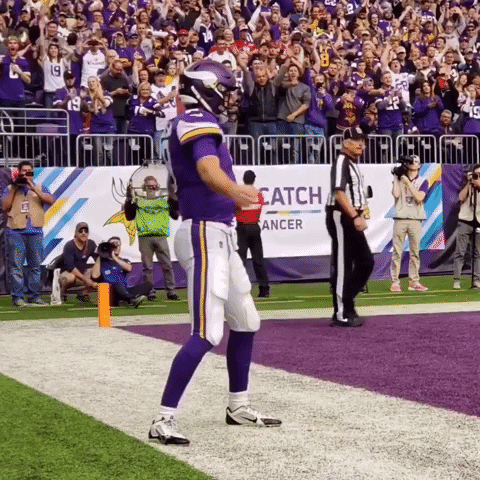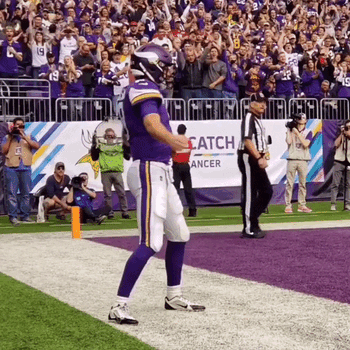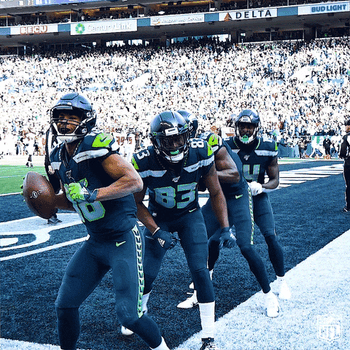Football Glossary

Quarters
Football is played in four quarters lasting 15 minutes each.
Downs
In the NFL you get four downs (attempts) to move ten yards. In the CFL you get only three.
Touchdown
A touchdown (TD) is worth six points. The touchdown zone is the big area at either end of the football field that the teams are trying to get to, or trying to prevent the opposing team from getting to. Football is known for some super fun celebrations. Check out some of these sick cellys.
Field Goal
There are yellow goal posts that look like a T + H had a baby in the touchdown zones. It’s the kicker’s job to get the ball between those two posts (called uprights).
A field goal is worth three points.
Red zone
The area of the field that’s between the 20-yard line and the touchdown zone. It’s called the red zone because there’s a higher probability for the offensive team to score when they’re this close to the touchdown line/in field goal range.
One point convert
After a touchdown, the kicker needs to kick the ball through the uprights to get an additional point.
Two point convert
If a team really needs points, they’ll sometimes go for a two-point convert instead of a one-point convert. This is when the team sets up a play from the two-yard line to get back into the touchdown zone. This is MUCH harder to do and a riskier play, but sometimes every little point (or inch) matters.
Punt
If a team doesn’t make it the ten yards they need to in three or four downs, they usually punt the ball to the other team on their last available down.
A punt is when the football gets snapped back to a kicker and they drop kick it as far down the field as they can (the farther they kick it, the farther down the field their opponent has to start from).
Snap(per)
The player the quarterback gets up close and personal with all game. They’re the one who passes the ball backwards between their legs to start a play.
Quarterback (QB)
The #1 stunna. The MVP. The GOAT. They are the leaders of the team who call the plays and throw, handoff or go alone to try and move the ball down the field.
Onside kick
At the beginning of each football game (and after every score) is a kickoff, with the defending team kicking the ball to the offensive team. Normally you want to kick it as far as you can so the other team has farther to bring the ball back and score.
An “onside” kick is when the team kicks the ball really short on purpose with the hope of recovering the ball and keeping possession. This is normally a tactic that happens at the end of the game if a team is down by a touchdown or field goal and has very little time to score. It’s also v. risky because if the opposing team still recovers the ball, they have amazing field position.
Running play
Football has two main types of plays: Passing (the ball is thrown through the air to gain yards) and running (the ball is handed off to a player who runs with it to gain yards).
Hail Mary
Desperate times call for desperate measures. A hail mary is when the ball is CHUCKED as far as possible and the team can only pray that someone catches it and scores a touchdown. Also how legendary moments like these plays are made.
Foul (Flag on the play)
Officials throw their flags onto the field in order to call a foul when a rule is broken. The refs then move the team BACK (away from the precious touchdown zone) by a certain amount of yards - 5, 10, or 15 depending and can even change downs depending on how big of a rule break it was.
Challenge
The head coach of each team can “challenge” a call twice a game when they disagree with the official’s call. They can call a challenge by throwing out a red flag onto the field. If they lose a challenge, they lose a time out.
Interception
When one team’s quarterback throws the ball, but the other team catches it. Accidents happen even to the pros.
Pick six
When there’s an interception and the other team is able to run it all the way back to get a touchdown (and the six points).
Sack
This is when the defense tackles the quarterback before they’re able to throw the ball. This is HUGE because it often means the offensive team loses yards on the play.
Super Bowl
The biggest football game of the year. This is where the best team from the AFC squares off against the best team from the NFC to be named the NFL champion. The Super Bowl is also known for the insanely overpriced commercials, the usually star-studded halftime show, eating until you faint, and drinking your pain away when your team loses.
AFC & NFC
Stands for American Football Conference and National Football Conference. The AFC and NFC have 16 NFL football teams in each, further split into divisions.
History check: There once was two professional leagues in the States: the American and National Football Leagues. They combined to form the NFL as we know it today in 1966, but maintained the two separate conferences.
Grey Cup
On the north side of the border, the CFL (Canadian Football League) teams play for the Grey Cup. The best team in the East and the best team in the West go toe to toe to win the coveted trophy. Although the party is not as rowdy, the Grey Cup still has halftime entertainment and an impressive turnout.
Calling an audible
Refers to changing the play on the fly. Players usually huddle up (gather) to decide on a play — run, pass, trick play etc. But sometimes the quarterback will change their mind based on what they're seeing on defence and yell out a slogan or reference to inform his team that the play is changing IN REAL TIME. You might also hear people use the phrase “calling an audible” for last-minute changes they make IRL.
Wide receivers (WR)
An offensive position in both the NFL and the CFL. Also referred to as wideouts or simply as receivers, these players tend to be the fastest on the field and are the best at catching the football.
Running backs (RB)
Another important type of offensive player, but instead of catching the ball, they’re main job is to run it. Running backs need to be quick and agile in order to find gaps in the defense. But like a big game of Red Rover, these guys also take a lot of hits and need to be built like a tank rather than the leaner builds of a wide receiver.
Tight ends (TE)
This position is a bit of an offensive hybrid because they play a role similar to a wide receiver, but are built like an offensive lineman (ie. bigger, taller, stronger). One of the best in recent memory is forever jokester Rob Gronkowski.
Kickers
When it comes to kickers, there’s punters and then there’s field goal specialists. A punter drop kicks the ball when the possession is about to turn over on downs, while a field goal specialist kicks from the ground on a kick off or for a (you guessed it) field goal.
Passing yards
The distance of a completed pass a quarterback throws. This includes the distance that player runs after catching the ball, not just how far the ball travels through the air.
Rushing yards
The total number of yards a single player runs as a result of a rushing play. A rushing play is where a player carries the football, as opposed to receiving it from a pass.
Fumble
Dropping the ball (literally). When the ball is fumbled, whichever team picks it up takes possession, even if it happens to be the same team that dropped it.
Blocked kicks
Blocked kicks are v. unlikely but this can happen when a player is kicking a convert or a field goal and the defensive team manages to stick up a hand and block the football from going through the goalposts. Impressive.
Injured Reserve (IR)
NFL coaches place a player on Injured Reserve (IR) when they are hurt or temporarily unable to play. Prior to a rule change in 2012, moving a player to IR meant they would be unavailable for the remainder of the season (luckily they would still get paid). Nowadays, teams can bring back up to two players off the IR per season.
Heisman Trophy
The Heisman Trophy is the MVP award of college football, awarded annually to the NCAA's most outstanding player. You might recognize the iconic pose associated with the trophy.
Power Five Conferences
Enjoying this article? Want more?

Sign up for The GIST and receive the latest sports news straight to your inbox three times a week.



